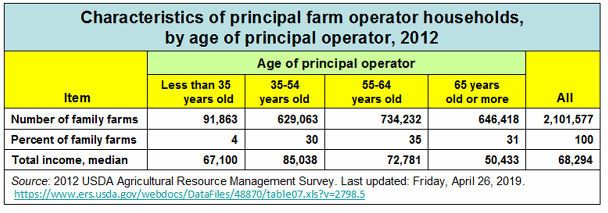The US Department of Agriculture (USDA) defines a farm as any place that produces and sells—or normally would have produced and sold—at least $1,000 of agricultural products during a given year. By this definition, the US currently has around two million farms. Here’s how they break down by type and gross cash farm income:
Since Gross Cash Farm Income doesn’t account for expenses, a better indicator of how farmers are doing financially is simply their household income. I have a table for that:
Note that most farms lose money (specifically, 54.2% of all farms have “negative income” from farming). Small farms in particular depend on off-farm income to survive. Midsize farm households do okay - but they take in a lot of nonfarm income too. Not counting the nonfarm income, midsize farm households earn about what a mid-career registered nurse makes. Large-scale farmers are doing a lot better On average, their household income is on par with what a typical plastic surgeon earns in a year.
It may seem odd that most farms lose money. Why, then, do so many Americans even own farms? Because they can, given their rather sizable off-farm incomes. I’m guessing that farming is more a labor of love than of economic necessity for many farmers, especially as they reach - or at least get close to - retirement age. And that situation applies to most of them:
Why does any of this matter? As a former career counselor, I find occupational data fascinating. But more than that, I think it’s essential we understand the realities of farming life to formulate policies and initiatives to help farmers become better stewards of the environment.
Reference:
USDA Economic Research Service. America’s Diverse Family Farms (2018) https://www.ers.usda.gov/webdocs/publications/90985/eib-203.pdf?v=6080


